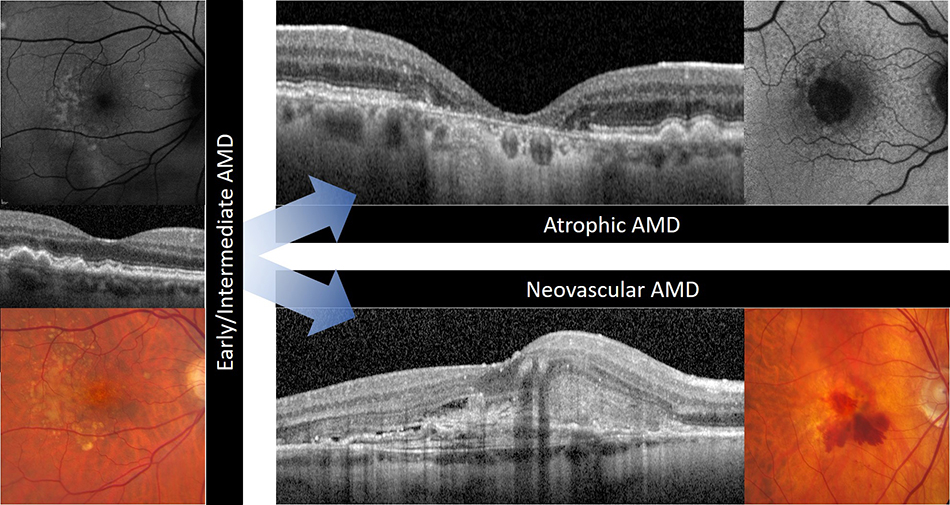Newly published research identifies clinical differences in the progression of age-related macular degeneration based on the genes directing it.
Researchers have linked patient genetics to different rates of disease progression and vision loss in age-related macular degeneration (AMD), identifying groups of patients that reach late-stage disease first.
A cluster of six genes on chromosome 1 and a pair of genes on chromosome10 are the most highly associated with the development of AMD, a leading cause of blindness for adults 55 and over. Scientists at the John A. Moran Eye Center’s Sharon Eccles Center for Translational Medicine (SCTM) and Utah Retinal Reading Center (UREAD) analyzed thousands of retinal images to investigate disease progression in three subgroups of AMD patients that were selected based on their genetic background:
- 317 patients with two copies of genetic risk variants (homozygous) at chromosome 1 only
- 93 patients homozygous at chromosome 10 only
- 92 patients homozygous at both chromosome 1 and chromosome 10
The scientists determined patients homozygous at both 1 and 10 reached sight-threatening late-stage AMD the earliest, within a median of 4.4 years. In comparison, patients homozygous at chromosomes 1 or 10 only took longer—within a median of 6.3 years and 10.4 years—to develop either late-stage atrophic or neovascular AMD. The latter is characterized by abnormal blood vessel development and ruptures, while both atrophic and neovascular forms of the disease cause severe damage and loss of retinal cells.
Researchers also found important and consistent differences in rates of vision loss among the groups. Patients homozygous at both 1 and 10 were 2.1 times more likely to develop a loss of two or more lines on the visual acuity chart as compared to patients homozygous at 1 only.
Based on more than 4,000 participants enrolled in clinical and genetic studies between 2009 and 2020 at the SCTM, the findings were published in JAMA Ophthalmology on Feb 3.
"Linking genetics to the clinical manifestation of AMD is essential to better understand the underlying disease mechanisms and variable rates of progression," said the study’s first author and UREAD Director Steffen Schmitz-Valckenberg, MD. "We need this information to improve the design of effective clinical trials to evaluate new therapies for AMD."
Study co-author Monika Fleckenstein, MD, said while the findings should be validated in other cohorts, "It is exciting to observe that the two major AMD-associated genetic loci have a differential impact on disease manifestation and progression on a patient level."
SCTM Executive Director Gregory S. Hageman, PhD, noted the study, along with prior SCTM publications, support the concept that AMD is at least two biologically distinct diseases rather than a single disease.
Researchers now plan to conduct similar studies for additional AMD patient genetic sub-groups.
These research data are reported in "Progression of Age-Related Macular Degeneration Among Individuals Homozygous for Risk Alleles on Chromosome 1 (CFH-CFHR5) or Chromosome 10 (ARMS2/HTRA1) or Both." Authors are: Steffen Schmitz-Valckenberg, Monika Fleckenstein, Moussa A. Zouache, Maximilian Pfau, Christian Pappas, Jill L. Hageman, Elvira Agrón, Claire Malley, Tiarnan D. L. Keenan, Emily Y. Chew, and Gregory S. Hageman.
The work was supported in part by an Unrestricted Grant from Research to Prevent Blindness, New York, NY, to the Department of Ophthalmology and Visual Sciences, University of Utah.

About the John A. Moran Eye Center
The John A. Moran Eye Center at the University of Utah serves as the largest ophthalmology clinical care and research facility in the Mountain West, with more than 60 faculty members and 10 satellite clinics. Physicians provide comprehensive care in all ophthalmic subspecialties, making the Moran Eye Center a major referral center for complex cases with over 157,000 patient visits and about 9,000 surgeries annually. Moran supports 16 research laboratories and centers.
Its Sharon Eccles Steele Center for Translational Medicine uses public-private partnerships to turn lab discoveries into therapies quickly. The Utah Retinal Reading Center specializes in the standardized and systematic analysis ("grading") of retinal imaging data within multicenter observational studies and interventional trials.